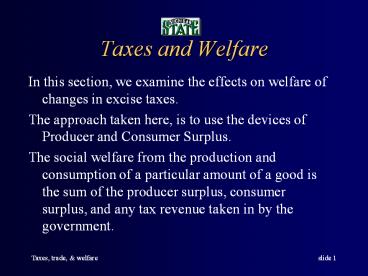Taxes and Welfare PowerPoint PPT Presentation
Title: Taxes and Welfare
1
Taxes and Welfare
- In this section, we examine the effects on
welfare of changes in excise taxes. - The approach taken here, is to use the devices of
Producer and Consumer Surplus. - The social welfare from the production and
consumption of a particular amount of a good is
the sum of the producer surplus, consumer
surplus, and any tax revenue taken in by the
government.
2
What are the welfare effects of an excise tax on
beer?
P
S
P
D
Q
Q
BEER MARKET
3
CHANGE IN CS -a - b CHANGE IN PS -c - d TAX
REVENUE OF GOV'T a c So social cost b d
S t
P
TAX PER UNIT
S
a
b
P
d
c
D
Q
Q
BEER MARKET
4
- Economists call the loss in social welfare due to
the tax - THE DEADWEIGHT LOSS
- from the tax.
5
Illustrating the deadweight loss
- The following hidden slide shows the changes in
surplus and the deadweight loss due to an excise
tax.
Hidden slide
6
What happens to welfare when an excise tax is put
on a good?
New consumer surplus
P
P
S
S
P'
P' - t
D
D
Q
Q0
Q0
Q
New producer surplus
7
- The size of the deadweight loss is determined by
- 1) The elasticity of the demand curve.
- 2) The elasticity of the supply curve.
- 3) The amount of the tax per unit.
8
- The following hidden slide shows the effect of
demand elasticity on the size of the deadweight
loss in welfare due to an excise tax.
Hidden slide
9
The more elastic the demand curve, the greater is
the deadweight loss.
/Q
/Q
S
S
Delast
Dinelast
Q
Q
Equal Pretax Sales
10
- Economists use terms such as "distortion of the
market" to describe the loss. - The deadweight loss is an example of an economic
inefficiency.
11
The following hidden slide shows the effect of
supply elasticity on the deadweight loss due to a
tax.
Hidden slide
12
The more elastic the supply curve, the greater is
the deadweight loss.
/Q
/Q
Selas
Sinelas
D
D
Q
Q
Equal Pretax Sales
13
The following hidden slide shows the effect of
demand elasticity on the governments tax revenue.
Hidden slide
14
The more elastic the demand curve, the smaller is
tax revenue.
/Q
/Q
S
S
Delast
Dinelast
Q
Q
Equal Pretax Sales
15
- Notice that this analysis can also be applied to
subsidies - A per unit subsidy will create a DEADWEIGHT LOSS
in social welfare. In the case of the subsidy
too much of society's resources will be devoted
to the good.
16
Trade and Welfare
- In this section, we examine the effects on
welfare of international trade. - The approach taken here, is to use the devices of
Producer and Consumer Surplus. - The change in social welfare when trade is
allowed can be measured by the changes in
producer and consumer surplus.
17
The diagram below shows the U.S. domestic market
for wine. No trade is taking place.
P
S
P 10
D
Q
Q
WINE MARKET
18
- In the case of wine, let's suppose the world
price is lower than the U.S no-trade price, say,
8.00 per bottle.
19
What happens with trade? What are the welfare
effects of trade?
P
S
P 10
P 8
D
Q
Q
Q"
Q'
WINE MARKET
20
U.S. consumers gain b d. U.S. producers lose
b. Welfare rises by d.
P
S
a
P 10
b
d
P 8
c
D
Q
Q"
Q'
WINE MARKET
21
The next (hidden) slide shows in a dynamic way
who gains from trade when the world price is
below the domestic, no trade price.
Hidden slide
22
Welfare changes due to imports of wine
New CS
No trade CS
/Q
/Q
S
S
World price
D
D
New PS
Q
Q
Q
No trade PS
23
The diagram below shows the U.S. domestic market
for computers. No trade is taking place.
P
S
P 1500
D
Q
Q
COMPUTER MARKET
24
- Suppose computers can be sold for 2000 each on
the world market and trade is allowed. - What happens with trade?
- What are the welfare effects of trade?
25
U.S. consumers lose b. U.S. producers gain b
d. Welfare rises by d.
P
S
a
P 2000
d
b
P 1500
c
D
Q
Q
COMPUTER MARKET
26
The next (hidden) slide shows in a dynamic way
who gains from trade when the world price is
above the domestic, no trade price.
Hidden slide
27
Welfare changes due to exports of computers
World price
New CS
No trade CS
/Q
/Q
S
S
D
D
Q
Q
Q
No trade PS
New PS
28
Summary and conclusions
- Allowing trade in a good will always increase
social welfare (the sum of producer and consumer
surplus). - When a good is exported, suppliers gain and
consumers lose, compared to the no trade
position. - When a good is imported, suppliers lose and
consumers gain, compared to the no trade position.

